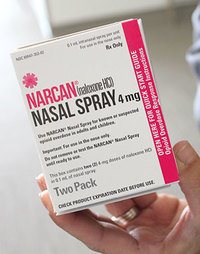Pain Killers or Killer Pain? Providing an Antidote for Accidental or Non-accidental Opioid Overdose
by Jessica Carruth
June 2021
Chronic pain is one of the most common reasons people see doctors – it's also one of the most notoriously difficult conditions for physicians to manage. Why? Though scientists are working to better understand long-lasting pain, experts do know that each individual's experience is unique, varying with how a person's brain interprets an uncomfortable sensation or someone's threshold for discomfort. For example, some people with right-sided abdominal pain will go straight to the emergency room and get an early diagnosis of appendicitis, while others may be able to ignore that pain until their appendix ruptures.
Healthcare providers have a variety of medications for pain management. Depending on the source and the severity of a patient's pain, common provider choices are anti-inflammatory medications, like ibuprofen and aspirin. Other medications frequently used are antidepressants or anti-seizure medications which can alter the way the body perceives pain and influence the body's pain pathways. Some pain sensations can be decreased by surgical procedures that cut the nerves. Implantable devices exist that can deliver medication directly to the nervous system where the sensation of pain lives. For some patients, pain can be improved by physical therapy or even counseling to train their brain to think differently about pain.
Many sources of pain can be partially improved by a medication familiar to almost everyone: opioids. Opioids provide relief by changing the brain's interpretation of pain and masking it with a release of feel-good chemicals. But what happens when the focus shifts toward the continuous high of “feeling good” and away from pain management? As the saying goes, it starts with admitting there's a problem.
The U.S. uses 80% of the world's painkillers, despite having less than 5% of the world's population. As the study of pain continues and healthcare providers try to properly prescribe opioids for short- and long-term pain relief, many people will still develop opioid misuse problems. According to the National Institute On Drug Abuse, up to 30% of patients given opioid prescriptions for chronic pain misuse them. Nearly 15% can actually develop opioid use disorder (OUD), previously referred to as opioid addiction, a physical and mental dependence on opioids.
Bringing things even closer to home, in Swift County alone, opioid prescriptions are written at an average rate of 500 prescriptions per 1,000 people – or about 50% of the county's residents. Translation: For this county of 9,359 individuals, that would mean there is about 4,933 opioid prescriptions floating around. And Minnesota “nice”, doesn't necessarily ward off the bad outcomes. For example, when unintentional misuse leads to an overdose. According to the Minnesota Department of Health (MDH), from 2000 to 2017, opioid-involved deaths for Minnesotans increased 681% – not very “nice” at all. Swift County is not immune either: In the last five years, opioid overdoses claimed two lives and there were no deaths from heroin, cocaine, and methamphetamine.
Literally billions of U.S. dollars are focused on changing opioid misuse statistics. Approaches range from changing provider prescribing habits to awaiting new non-addictive medications. Another important approach proven to decrease opioid overdose death statistics is the use of the medication naloxone. Carefully studied in overdose prevention programs, naloxone — which works like an antidote for opioid overuse — has been shown to decrease overdose deaths by over 45% when used correctly by friends, family, or first responders.

of naloxone.
Because of naloxone's effectiveness, five states have mandated co-prescription laws, meaning if an opioid is prescribed, naloxone must also be prescribed. Many naloxone advocates suggest that any provider who prescribes opioids should be involved in a stewardship program to understand and promote naloxone. In many locations, naloxone training is a new standard for most first responders and emergency medical technicians, as well as healthcare workers who are often responsible for patient training on the use of naloxone when prescribed.
With the increase in opioid use and OUD over the years, chronic pain has changed from being one individual's problem to a problem that affects everyone. While it is important to manage pain appropriately, it is also important to use pain medications safely and effectively. Opioid-prescribing changes are happening right here in Minnesota, particularly in regards to increasing availability of naloxone. Physicians may prescribe naloxone, pharmacies may enter into programs to dispense naloxone for anyone at risk or to those who know someone at risk for opioid overdose. MDH now distributes naloxone to the state's eight regional EMS providers. Law enforcement personnel, too, have begun to carry this life saving drug. Finally, as part of the State Targeted Response Grants through Department of Human Services, Minnesota organizations were awarded funds to provide naloxone overdose training and naloxone kits free of charge. Naloxone will best benefit the community if more community members adopt an “I can” approach to using naloxone. For more information regarding naloxone, check the MDH website.
This article also appeared in the July 7, 2021 issue of the Swift County Monitor.
About the Author
 Jessica Carruth is a third-year
medical student at the University of North Dakota School
of Medicine & Health Sciences. She was selected as the
Benson participant for the school's ROME program, or
Rural Opportunities in Medical Education. Because the
program includes teaching student doctors the importance
of how rural newspapers can deliver health information,
she has written this column for her ROME community. The
information is not for diagnosis or treatment and should
not be used in place of previous medical advice provided
by a licensed practitioner.
Jessica Carruth is a third-year
medical student at the University of North Dakota School
of Medicine & Health Sciences. She was selected as the
Benson participant for the school's ROME program, or
Rural Opportunities in Medical Education. Because the
program includes teaching student doctors the importance
of how rural newspapers can deliver health information,
she has written this column for her ROME community. The
information is not for diagnosis or treatment and should
not be used in place of previous medical advice provided
by a licensed practitioner.
